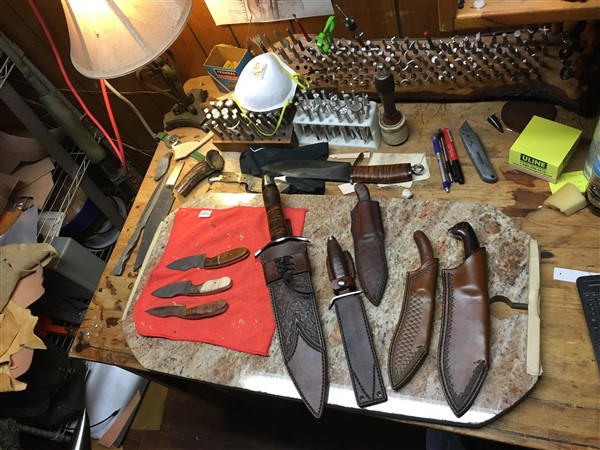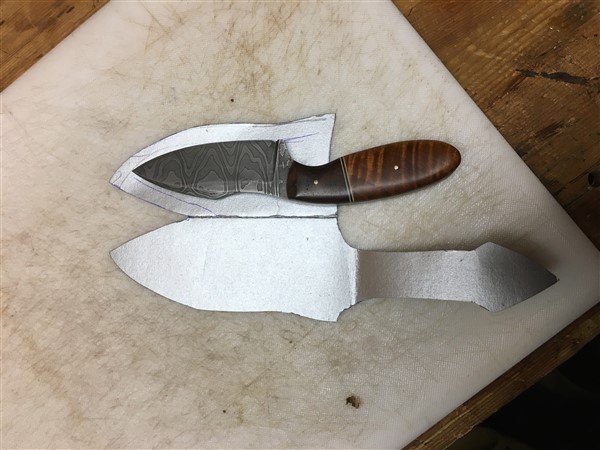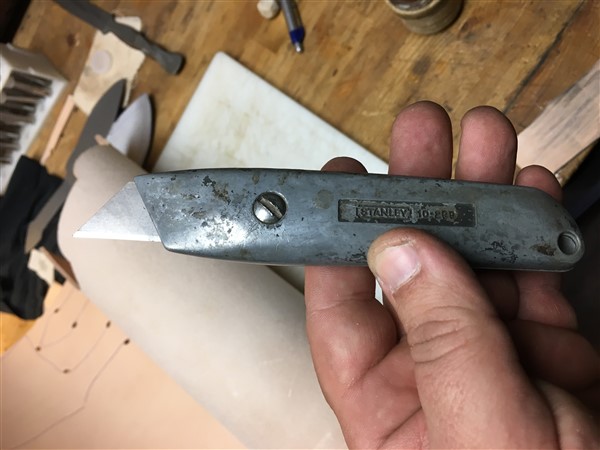I've been investing some time into taking pictures to put another tutorial together. I recently finished a couple small belt knives and needed to make sheaths for them. I had many members ask about sheath making, so here it goes. I will attempt to be as through as possible. If there is further clarification needed, please ask. I hope this comes out clearer than mud. As I have said before, a lot of the following content will be my version after doing this craft continuously for quite a while. If someone wants to share a better way, please jump in.
There are as many different designs of sheaths as there are makers. Once you get the basic concept of how to put one together, you can kick your imagination loose.
I am going to document and illustrate the process for creating a simple pouch sheath with an integrated belt loop. When designing a sheath, you will need to have some answers to questions that will arise right off the bat. What carry position/ height is desired? How much handle exposed? How will be sheath be secured on your person? In this examples case, I am going with vertical carry, 2/3 of handle exposed, integral belt loop.
After those decisions are made its time to start on a pattern. First, trace the knife then roll it on its spine and trace it again. Add at least 3/8" around the perimeter of the blade to allow for the welt that will be sewn in to protect the stitching from the blade.
Fold the pattern to ensure that the coverage matched what you had in mind and verify that the belt loop fits the desired carry height and position.
Trace the pattern on to your veg tanned leather ensuring that the outer surface of the sheath is in top while tracing. I use a ball point pen for better visibility. It can make a mess if you are not careful. It would be safer to use a pencil starting out, just harder to see.
You will notice a bunch of holes punched in the leather. I use an oval punch designed for creating holes in belts.
I punch out the areas that are difficult to cut with a knife due to the tight radius combined with the thickness of the leather. While on the topic of cutting leather, I only use a utility knife with a new razor that I strop with jewelers rouge to a mirror edge. It simply glides thru the leather.
Next step is actually cutting out the leather pattern, making sure that you do not cut inside the outline. Notice on this close up how smooth this transition is where the hole was punched previously.
Now take the knife pattern and trace the welt onto a piece of leather.
Check for proper fit with the blade, then cut out the welt. This can be set aside for later use.
Now that you created a pattern and cut it out, you need to finish the leather. If you simply want to stitch the sheath, my earlier stitching tutorial will get you there. If you want to add some style, follow along.
To tool/ carve leather it has to be "cased" first. This is the process of wetting the leather and allowing time for the surface to dry out leaving the center moist. This allows for deep accurate stamping that gives you the must detail/definition.
If leather is stamped dry, you will not get the depth necessary for the detail of the tooling.
If the leather isn't given time to dry them the stamps will go too deep and will not hold the detail as it continues to dry.
When thoroughly wetted and given time for the surface to return to its almost dry color
(top piece)
you will get as much detail as possible. A telltale sign that your leather has the correct moisture content is the fact that the leather will turn brown from burnishing while you are tooling.
At this point, you need to ensure that your hands are very clean by washing them. The leather in its wetted state is more absorbant than any sponge, if you have dirt, grease, oil on your hands...the leather will absorb it and its aint coming out.
Now place the leather under running cold water and saturate it. you want keep it under the faucet until the surface stops absorbing water. Once water coats the surface, wipe thw surface lightly with a CLEAN rag and set the leather aside.
Nows as good of a time as any to talk about additional necessary tooling. You will need a piece of granite to stamp on. You can buy a piece from any leather tool supplier ie Tandy, Springfield, ect.
If you can locate a company who sells granite counter tops, they will have a dumpster full of cut outs. I have had a kitchen sink cut out that I have been tooling on for over 20 years.
You will want to place some kind of padding on its back to isolate it from the table surface.
The remaining tools needed will be wing dividers
an edger
and a leather workers mallet
I made mine but any rawhide headed mallet about 12oz or heavier will do. A little weight helps with control so you dont have to exert effort to get the power you want for the depth of punching.
Now give that leather some time to dry, it will make all of the difference between well tooled or not.
Lets cover one more tool you will need. A swivel knife.
This specialty leather tool allows you to make very controlled cuts into the leather that allows the depth that you see in carvings.
It is held between thumb and middle finger with pointer finger riding in the saddle.
The cut is started by tilting the knife away from you and pull towards you, rotating the barrel (part between your fingers) to follow the line.
The heel of your hand is used to adjust the depth of the cut.
Ok,Back to your leather. So now that you have a properly cased piece of leather, lets have some fun. First, lets take the edger and lets take off the sharp corner that was caused by the knife cut.
Now you are going to use the wind divider and make a line about as wide as the welt around the edge of the sheath. Refer back to the picture of how to use the swivel knife.
Now use the swivel knife to cut the line you just made. The swivel knife should cut about 1/3 of the leather in depth.
Note the deep line cut around the pattern.
Next you will take a beveler and push down one side of the line you cut.
If you look closely at the beveler, you will notice that one side is taller than the other. The taller side goes against the line that was cut and depresses the leather when hit with the mallet. This will cause a noticeable ridge around the perimeter of the sheath. The challenge here is to get used to walking the beveler along the cut, striking it with the mallet and getting a smooth depression along the entire edge. Somethings just take time and practice.
Next step it to take whatever punches you want to use, or have on hand to do a border pattern with.
The key to this step is even spacing.
The next two tools were highlighted in the hand stitching tutorial.Now take the stitching groover and put the groove down the middle of your welt line.
Now you use your overstitcher to get your stitch line layed out.
To make the pattern that you saw thru out this tutorial, I used these punched for the pattern
and these for the border
Now set the sheath aside and let it dry completely. Depending on climate that might take up to 48 hours.
Once these are dry, I will continue till you see finished sheaths.
Take care,
This is a fabulous tutorial and I want to personally thank you for the time you put in. I know what it's like.
It gives me some encouragement to expand my sheath making.
Karl B. Andersen
Journeyman Smith
Great tutorial ! Thank you for posting.
Tomas Great Wip!! Thanks for sharing!!
Want to see more of my work follow me on Instagram:JasonVolkertKnives
Want to get in touch with me [email="JasonVolkertKnives@gmail.com"]Email[/email] me.
This a great tutorial, thanks for doing it. One solid bit of advice to any new maker is that the sheath is what sells the knife. If you can't make good ones you really need to find somebody who can, but definitely develop the ability to craft a decent sheath if you want to have better sales.
|quoted:
Next step it to take whatever punches you want to use, or have on hand to do a border pattern with.
The key to this step is even spacing.
The next two tools were highlighted in the hand stitching tutorial.Now take the stitching groover and put the groove down the middle of your welt line.
I especially like how you used these tools in a way that resulting in shading an highlighting of the pattern in a 3-D way and not just aligned to form a basic flat pattern. In many of images it is obvious that you are "drawing' with the tools and not just stamping patterns due to the 3-d effects you are getting. Well done.
"One test is worth 1000 'expert' opinions" Riehle Testing Machines Co.
100% agree with Kevin about the impact that learning to build a decent sheath on sales.
Nothing against those who specialize in sheath making, because they are some of the finest craftsmen around, but over the years I have seen far too many fantastic knives, that had sheaths made by someone other then the knifemaker.....and the only way I know how to say it is....the sheath(s) just do not go with the knife/knives. The quality of both were outstanding....but visually they just didn't go together.
Personally, I'd rather have my toes smashed with a hammer then do leather work, BUT, also having tried using outside sources, and finding what I mentioned above about the sheath just not matching/going with the knife, I suck it up, and build my own sheaths.
I never realized it until just a couple of years ago..... but and after having a number of clients comment on how much they like my sheaths, and then my Mrs telling me that my sheaths often sell my knives.... I guess I don't hate it as much as all that.....but I still am not a huge fan of working "Dead Cow's hides". <img src=' http://www.americanbladesmith.com/ipboard/public/style_emoticons//smile.gi f' class='bbc_emoticon' alt=':)' />
Ed Caffrey, ABS MS
"The Montana Bladesmith"
www.CaffreyKnives.net
|quoted:
...Personally, I'd rather have my toes smashed with a hammer then do leather work,
... I still am not a huge fan of working "Dead Cow's hides". <img src=' http://www.americanbladesmith.com/ipboard/public/style_emoticons//smile.gi f' class='bbc_emoticon' alt=':)' />
These were my feelings exactly, and then one year I had a very good Blade show and was walking around looking for equipment and tools to buy. And as I shopped forging stuff and grinder gadgets, I said to myself "Why am I throwing money at things that I like doing so much that I would still have fun with the worst of tools, instead of investing in tools to make the miserable jobs better?"
The next step was a no brainer, I started looking at leatherworking equipment!
I hated working leather and it was reflected in my sheaths. When I moved my leather working out of a dark, dingy corner of my basement and devoted a bright and well lit area of my shop to nice leather tools, my attitude began to change and it immediately showed in my work. The positive feedback about the leather caused me to enjoy doing it all the more and soon the leatherwork was as fun as the other tasks.
But back to the importance of the sheath. When I had an attitude about sheaths I used to keep them under the table and let my knives do the selling. But I quickly noticed that they only time I had a definite sale was when they asked to see the sheath. While I was getting the sheath out, I would always grab the receipt book, because I was going to need it if they were serious enough to ask to see the sheath. When I started displaying my sheaths right next to the knives everything changed and sales where a lot easier.
You can make the most stunning damascus blade you ever crafted, but what the public sees when the owner wears it is that sheath, and it is every bit as much of that package as the blade. Sheaths are the one area where tough outdoorsman type guys will "accessorize" like a group of house wives in a Gucci store! They will wring their hands over whether all the leather tones fully match or compliment the handle material, while holding them, side by side, like they are getting ready to strut the catwalk with it. You are missing a huge part of selling knives if you are not keyed in on that. <img src=' http://www.americanbladesmith.com/ipboard/public/style_emoticons//wink.gi f' class='bbc_emoticon' alt=';)' />
"One test is worth 1000 'expert' opinions" Riehle Testing Machines Co.
Thank you for all of positive feedback on this write up. I have a strong desire to "pay it forward" for all of the effort you guys put into helping us new guys learning the ropes that you are so used to handling. If it ever stops raining, I'll get the dye applied and keep the ball rolling. If this helps one person work up the courage to attempt a sheath, then the effort was well worth it.
I have to tell you, I have burned out on leather work compared to what I used to do with it. I got involved in following the Cowboy Action Shooting Society and sold a bunch of dolled up gun-rigs, and tons of instrument straps to bluegrass types, when I was into running around with that crowd. Having the knife hobby has kept me going at it for the same reason that Ed and Kevin mentioned. Having so much experience with the leather, I can make a sheath that fits the knife, both in style and color. In all honesty, If I could find someone who was able to make the sheath I can picture in my head, I would give them my leather tools.
The kick in the pants that beginners need to realize is that the stuff is extremely unforgiving. One mistake 6 hours in, for me, means it gets thrown in the garbage and you start over. My best advise to someone just starting out with sheath making, would to learn to make a sheath that fits. There is no bigger kick in the teeth than to spend an entire weekend designing a sheath and tooling it to your own personal level of perfection, then to assemble and the knife will not fit. Keep is simple until you are competent with the basics, then progress. Its no different than any other learned craft. Master the basics, then embellish. Personally, knives I keep get plain sheaths because I would rather see the lines of the knife.
With that said, I do get satisfaction out of creating a completed "finished" good. A matching knife and sheath is a joy to look at, carry, use, maintain, ect.
Thanks again for all of the support Fellas.
Somehow I missed this, and it is brilliant. Thanks.
Joshua States
www.dosgatosforge.com
https://www.youtube.com/channel/UCdJMFMqnbLYqv965xd64vYg
https://www.facebook.com/dos.gatos.71
Also on Instagram and Facebook as J.States Bladesmith
“So I'm lightin' out for the territory, ahead of the scared and the weak and the mean spirited, because Aunt Sally is fixin’ to adopt me and civilize me, and I can't stand it. I've been there before.â€




































